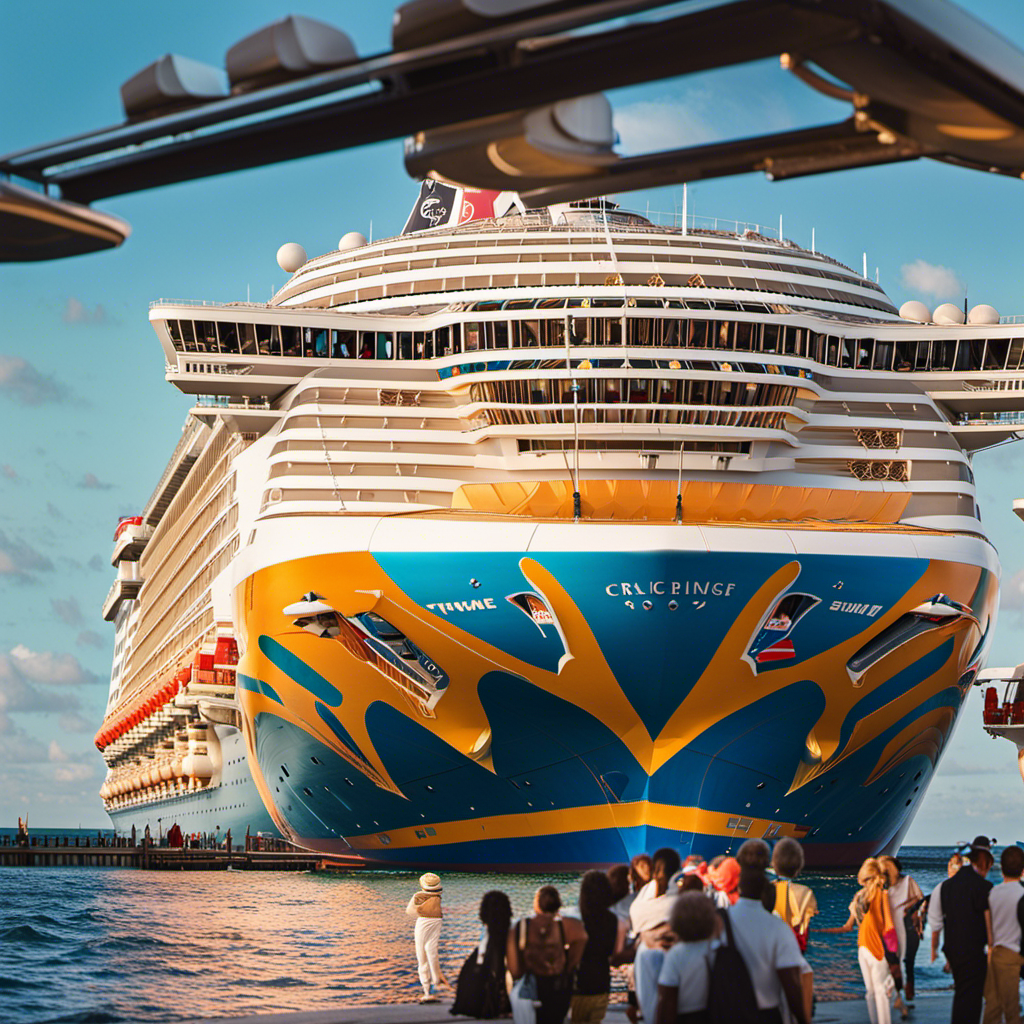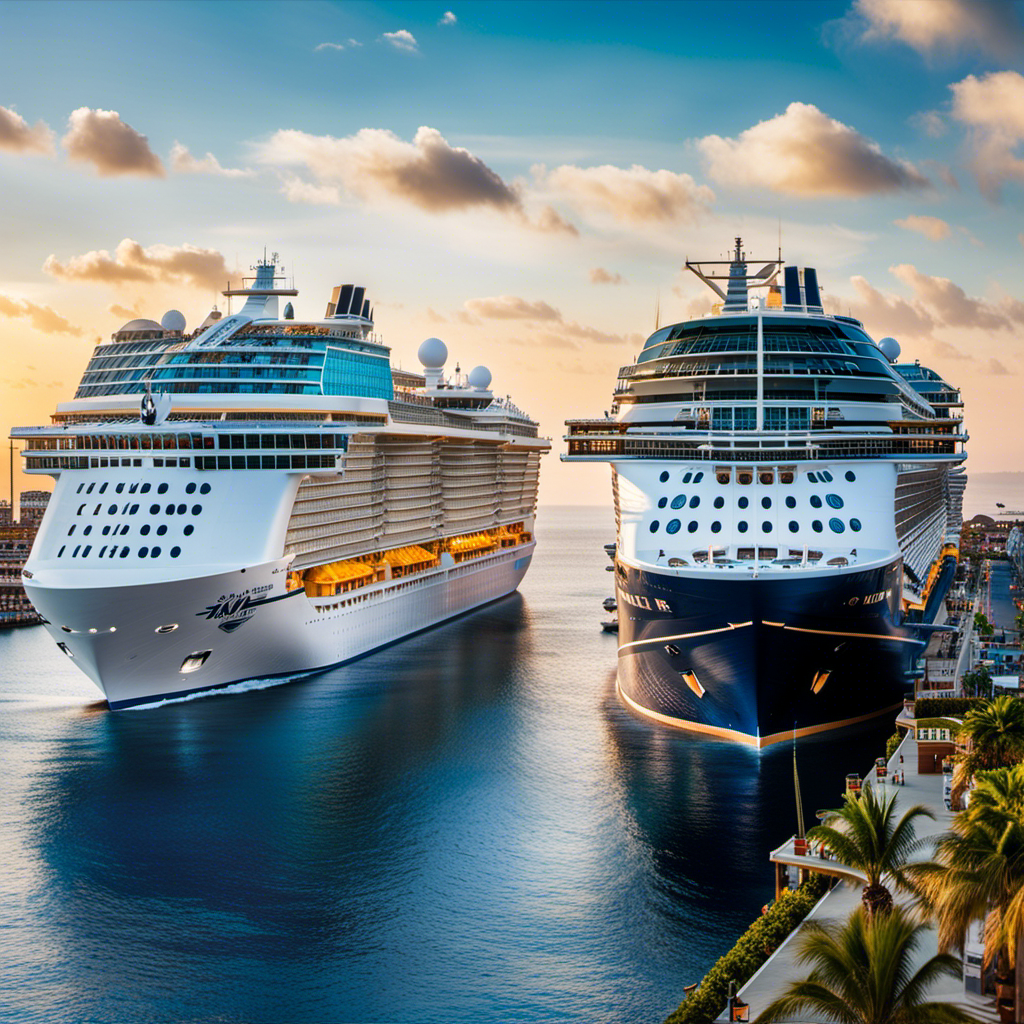Here we are again, facing a familiar scenario. It seems like the CDC is struggling to make up its mind on its position about cruise ships, right? At first, they were quite adamant about recommending those who are not vaccinated to avoid these floating germ incubators.
But now, even if you’re fully vaccinated, they’re saying it’s still a no-go for higher-risk groups. Yeah, apparently the Delta variant is causing quite a stir, with COVID cases skyrocketing. And get this, being vaccinated doesn’t guarantee you won’t end up in the hospital or worse.
So, if you’re in a higher-risk category, it might be best to steer clear of those cruise ships for now.
Key Takeaways
- CDC recommends higher-risk groups to avoid cruises, even if vaccinated
- Delta variant has led to a surge in COVID cases and breakthrough cases can still occur in fully vaccinated individuals
- CDC assigns color-coded status to U.S.-based cruise ships, with over half having possible cases or reporting issues
- Cruise lines are implementing stricter protocols and require negative COVID tests before sailing, but acknowledge that cruising cannot be a zero-risk activity for COVID spread.
Delta Variant and Increased Risk for Higher-Risk Groups
I’m aware that the rise of the Delta variant in the United States has increased the risk for higher-risk groups, and even though I’m fully vaccinated, I should still be cautious about cruising.
The Delta variant has had a significant impact on the effectiveness of vaccinations. While being fully vaccinated reduces the risk of severe illness and hospitalization, breakthrough cases can still occur. This means that even vaccinated individuals can contract and spread the virus.
The Delta variant is highly transmissible, leading to a ten-fold increase in new cases across the country. It’s important to note that vaccination of passengers and crew does not guarantee complete prevention of cases on ships.
Therefore, it’s crucial for higher-risk individuals to consider the potential risks and follow CDC recommendations to avoid cruises at this time.
Breakthrough Cases and the Importance of Vaccination
Experiencing a breakthrough case of COVID-19 can still occur even if I’m fully vaccinated. While vaccines have proven to be highly effective in preventing severe illness and hospitalization, they are not 100% foolproof. Breakthrough cases refer to instances where fully vaccinated individuals still contract the virus.
Implications of breakthrough cases include the potential for transmission to others, although vaccinated individuals are less likely to spread the virus compared to unvaccinated individuals. It is important to note that breakthrough cases are still relatively rare, and the majority of COVID-19 cases and hospitalizations are among the unvaccinated population.
To evaluate the effectiveness of vaccination, it is crucial to consider real-world data and studies. Research has shown that vaccines significantly reduce the risk of severe illness, hospitalization, and death. They also provide protection against variants, including the Delta variant. However, breakthrough cases reinforce the need for continued adherence to preventive measures such as wearing masks and practicing social distancing, especially in areas with high transmission rates.
The table below summarizes the implications and evaluation of vaccination effectiveness in breakthrough cases:
| Implications | Vaccination Effectiveness Evaluation |
|---|---|
| – Potential for transmission to others | – Vaccines greatly reduce the risk of severe illness and hospitalization |
| – Breakthrough cases are relatively rare | – Vaccines provide protection against variants, including Delta |
| – Majority of cases and hospitalizations are among the unvaccinated | – Continued adherence to preventive measures is important |
| – Vaccinated individuals are less likely to spread the virus compared to unvaccinated | – Real-world data and studies support vaccine effectiveness |
CDC’s Color-Coded Tracking System for Cruise Ships
The color-coded tracking system implemented by the CDC allows cruise ships to be categorized based on their COVID-19 case status. This system helps to monitor and assess the risk of transmission on these ships.
The CDC assigns a color-coded status to U.S.-based cruise ships, with green indicating no cases in the past seven days, and yellow or orange indicating possible cases or reporting issues. Currently, 51.5% of tracked ships have yellow or orange status.
In response to the ongoing pandemic, cruise lines have been implementing various measures to limit the spread of COVID-19 onboard. These include masking requirements, testing protocols, and vaccination mandates. The effectiveness of masking on cruise ships is an important aspect of these efforts, as it can help reduce the risk of transmission among passengers and crew members.
Yellow or Orange Status: Potential Cases and Reporting Issues
Implementing stricter protocols, cruise lines now require a negative COVID test before sailing, even for vaccinated guests. This is to ensure the safety of everyone on board and prevent the potential spread of the virus.
However, despite these precautions, there have been instances where potential cases and reporting issues have arisen. Here are some key points to consider:
-
Yellow or Orange Status: The CDC assigns color-coded statuses to U.S.-based cruise ships. Yellow or orange status indicates the possibility of cases or reporting issues. Currently, 51.5% of tracked ships fall under this category.
-
Breakthrough Cases: It’s important to note that even fully vaccinated individuals can still experience breakthrough cases. These cases can lead to hospitalization or even death, emphasizing the need for continued vigilance.
-
Reporting Issues: Cruise lines are working diligently to track and report any potential cases. However, with the complex nature of cruise ship operations, there may be reporting challenges that need to be addressed.
-
Continuous Monitoring: The CDC’s tracking system and cruise lines’ efforts to limit COVID spread on ships aim to minimize the risk associated with potential cases. As cases on land decrease, it is expected that cases on cruise ships will also decrease.
Stricter Protocols to Limit COVID Spread on Cruise Ships
I understand the importance of stricter protocols on cruise ships to limit the spread of COVID-19 and ensure the safety of passengers and crew.
These protocols have had a significant impact on the cruise industry. In an effort to limit COVID spread, cruise lines have implemented various measures.
One key protocol is requiring a negative COVID test before sailing, even for vaccinated guests. This helps to identify potential cases and prevent them from boarding the ship.
Additionally, cruise lines acknowledge that cruising cannot be a zero-risk activity for COVID spread. Despite these protocols, the impact on the cruise industry has been substantial. Many ships have been assigned yellow or orange status by the CDC, indicating possible cases or reporting issues.
It is expected that as cases on land decrease, cases on cruise ships will also decrease, leading to a safer environment for passengers and crew.
Negative COVID Tests Required for Vaccinated Guests
In order to limit the spread of COVID-19 on cruise ships, stricter protocols are being implemented by cruise lines. One important measure being taken is the requirement of negative COVID tests for vaccinated guests before sailing. This is a crucial step to ensure the safety of all passengers and crew members on board. Despite being vaccinated, individuals can still contract and spread the virus, although the risk is significantly reduced. By implementing the testing requirement, cruise lines are taking proactive measures to identify any potential cases and prevent the virus from spreading further. This is in line with the efforts to enforce stricter protocols, including masking and vaccination requirements. Although cruising cannot be a zero-risk activity for COVID spread, these measures are expected to greatly minimize the risk and create a safer environment for everyone on board.
| Importance of testing for vaccinated individuals | Cruise lines’ efforts to enforce stricter protocols |
|---|---|
| – Ensures safety of all passengers and crew members | – Requirement of negative COVID tests for vaccinated guests |
| – Reduces the risk of spreading the virus | – Proactive measures to identify potential cases |
| – Minimizes the risk of COVID spread on cruise ships | – Masking and vaccination requirements |
| – Creates a safer environment for everyone on board | – Efforts to greatly minimize the risk of COVID spread |
Cruising as a Non-Zero-Risk Activity for COVID Spread
Cruising can never be completely without risk for the spread of COVID-19. Despite efforts to limit the spread of the virus on cruise ships, it is important to recognize that cruising is a non-zero risk activity.
While cruise lines have implemented stricter protocols, such as requiring negative COVID tests before sailing and implementing masking, testing, and vaccination requirements, there is still a possibility of cases on board.
The impact of COVID-19 on the tourism industry has been significant, with many cruise lines experiencing cancellations and reduced bookings. However, as cases on land decrease and vaccination rates increase, it is expected that cases on cruise ships will also decrease.
It is important for individuals, especially those who are unvaccinated or higher-risk, to consider the potential risks before deciding to cruise.
Expected Decrease in Cases on Cruise Ships as Land Cases Fall
As land cases fall, it is expected that the number of COVID cases on cruise ships will also decrease. This decrease in cases on cruise ships will have a significant impact on the tourism industry. The cruise industry has been heavily impacted by the pandemic, with numerous outbreaks occurring onboard ships. However, as vaccination rates increase and stricter protocols are implemented, the likelihood of COVID transmission on cruise ships is decreasing. According to the CDC, 51.5% of tracked ships currently have a yellow or orange status, indicating possible cases or reporting issues. By implementing measures such as masking, testing, and vaccination requirements, cruise lines are working to limit the spread of COVID on their ships. This expected decrease in cases will be a positive development for the tourism industry, as it will help restore confidence in cruising and attract more travelers.
| CDC Tracking of COVID Cases on Cruise Ships | Status |
|---|---|
| No cases in the past seven days | Green |
| Possible cases or reporting issues | Yellow |
| Possible cases or reporting issues | Orange |
| ——————————————– | ——– |
Recommendations for Unvaccinated and Higher-Risk Individuals
I should consider the CDC’s recommendations to protect myself since I’m unvaccinated and in a higher-risk group.
The importance of vaccination cannot be overstated, especially in the face of the Delta variant and the surge in COVID cases. Even though breakthrough cases can occur in fully vaccinated individuals, getting vaccinated significantly reduces the risk of severe illness, hospitalization, and death.
To further mitigate the risk, cruise lines are implementing stricter protocols. These include requiring negative COVID tests before sailing and implementing masking, testing, and vaccination requirements.
However, it’s important to note that cruising cannot be a zero-risk activity for COVID spread. Therefore, unvaccinated and higher-risk individuals are advised to avoid cruising altogether.
Additional Information and Resources for CDC Guidance on Cruises
By exploring additional resources, I can gain a better understanding of the CDC’s guidance on cruises. The CDC provides valuable cruise resources that can help individuals make informed decisions about their travel plans.
These resources include articles related to CDC guidance on cruises, a list of the largest cruise ships, and information on the best cruise lines for first-time passengers. Additionally, there are resources available that provide information on hotels with cruise shuttles for major ports in America, as well as useful tips, tricks, and freebies for cruising.
Frequently Asked Questions
What Are the Specific Criteria for a Cruise Ship to Be Assigned a Yellow or Orange Status by the Cdc?
The CDC criteria for assigning a cruise ship a yellow or orange status depend on the presence of possible COVID cases or reporting issues. These statuses indicate a potential risk of infection on the ship.
Are There Any Specific Guidelines or Protocols That Cruise Lines Are Implementing to Limit the Spread of COVID-19 on Their Ships?
Cruise lines have implemented protocols to limit COVID-19 spread, including requiring negative tests for vaccinated guests. Safety measures for higher-risk individuals on cruises are advised, despite CDC’s recommendation for vaccinated individuals.
How Long Does the CDC Recommend Higher-Risk Individuals Avoid Cruises, Even if They Are Vaccinated?
The CDC recommends higher-risk individuals to avoid cruises, even if vaccinated. The duration of the recommended avoidance period is not specified. This recommendation is based on the increased risk of severe illness and the possibility of breakthrough cases.
Are There Any Specific Measures Being Taken to Ensure the Safety of Unvaccinated or Higher-Risk Individuals Who May Still Choose to Go on a Cruise?
Safety measures and cruise protocols are in place to protect unvaccinated or higher-risk individuals on cruises. These include strict testing requirements and enhanced sanitation practices. However, avoiding cruising is still advised for their safety.
What Resources or Information Can Individuals Refer to for CDC Guidance on Cruises, Apart From the Articles Mentioned in the Additional Information Section?
When looking for reliable resources on CDC guidance for cruises, I suggest checking the official CDC website. It provides up-to-date information on recommendations for higher-risk individuals and other important guidelines for safe cruising.










